So, you’ve decided to take the plunge and venture into the great outdoors this winter – that’s awesome! Winter hiking is a fantastic way to enjoy nature’s grandeur, but it does require careful planning, especially when it comes to deciding what to wear winter hiking.
You see, the wilderness doesn’t come with indoor heating and there’s no switch to adjust the temperature when you’re out in the open. The clothes you wear serve as your personal thermostat and your first line of defense against frostbite, hypothermia, and other winter-related hazards. Your outfit choice isn’t just about comfort, it’s a matter of safety too.
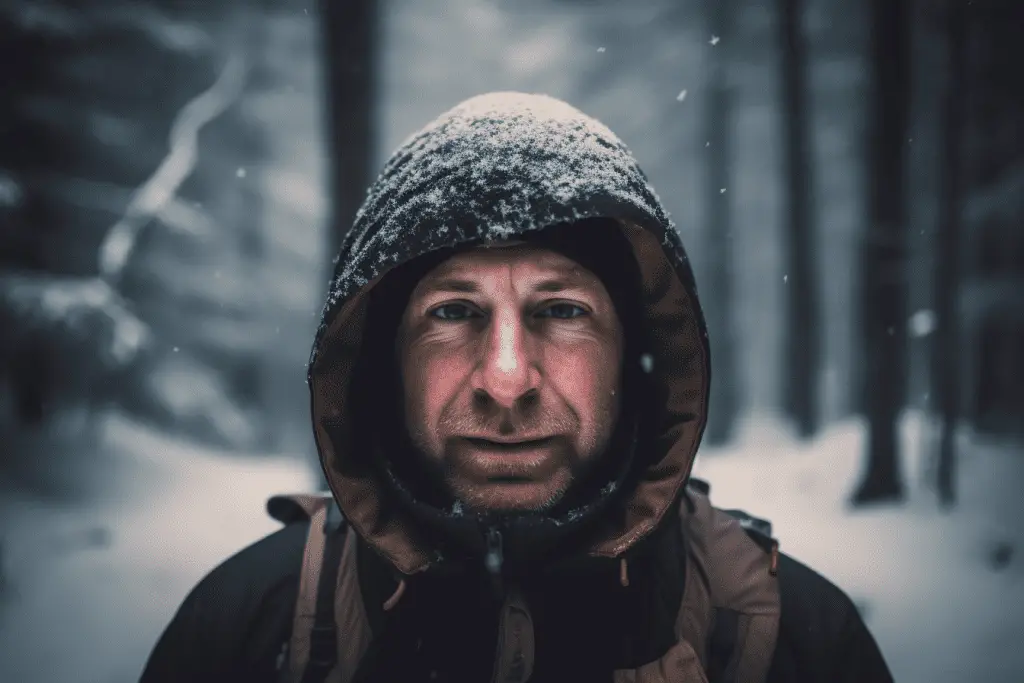
Getting your winter hiking attire right is all about understanding the demands of the environment you’ll be hiking in. That means considering the weather conditions, the intensity of the hike, and of course, your personal comfort. Choosing the wrong clothing can turn a potentially breathtaking winter trek into a frosty ordeal.
Remember, dressing for winter hiking isn’t about bulking up with the heaviest gear you can find. It’s about intelligent layering and choosing materials that balance warmth, breathability, and protection against the elements. But don’t worry – by the end of this blog post, you’ll be a pro at picking out the perfect winter hiking outfit. So stick around, and let’s make your winter hiking experience a warm and enjoyable one!
Understanding the Winter Hiking Environment
There’s a saying that goes, “There’s no such thing as bad weather, only inappropriate clothing.” And while we love the sentiment, let’s be honest: winter weather can be pretty unpredictable. From chilly winds that slice through your clothes to sudden snowstorms that blanket the landscape in a blink, knowing what you’re up against is key to deciding what to wear winter hiking.
When we think about winter hiking, we often picture a serene world cloaked in snow and ice. But the winter hiking environment is much more diverse than that. Depending on where and when you’re hiking, you could be facing anything from mildly cool temperatures to deep freezes, clear skies to blizzards, and everything in between.
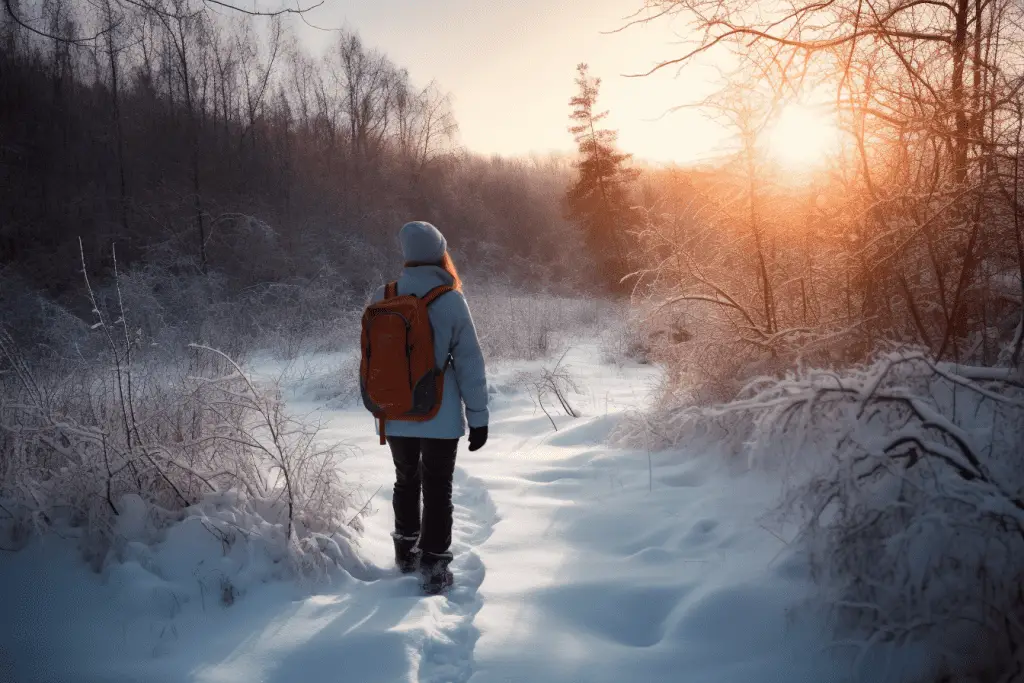
Not to mention, the conditions can change quickly. A sunny morning can give way to an afternoon snowfall. The temperature might drop dramatically as you ascend higher. And let’s not forget about the wind chill factor, which can make the air feel much colder than the actual temperature.
Understanding these environmental elements will help you prepare better and know what to wear winter hiking. For instance, if you’re hiking in an area prone to heavy snowfall, you’ll need waterproof outer layers to stay dry and protected. Similarly, if strong winds are common, a windproof shell can be a lifesaver, shielding you from the chilling gusts. Being aware of the specific conditions and choosing appropriate gear will ensure your safety and comfort on winter hikes.
But no matter the conditions, always remember: the weather has the upper hand. Always check the weather forecast before you head out and be prepared to turn back if things get dicey. Because in the end, safety should always be your priority, no matter how well you’ve nailed your winter hiking wardrobe.
Dressing Up Like an Onion: Layering for Winter Hiking
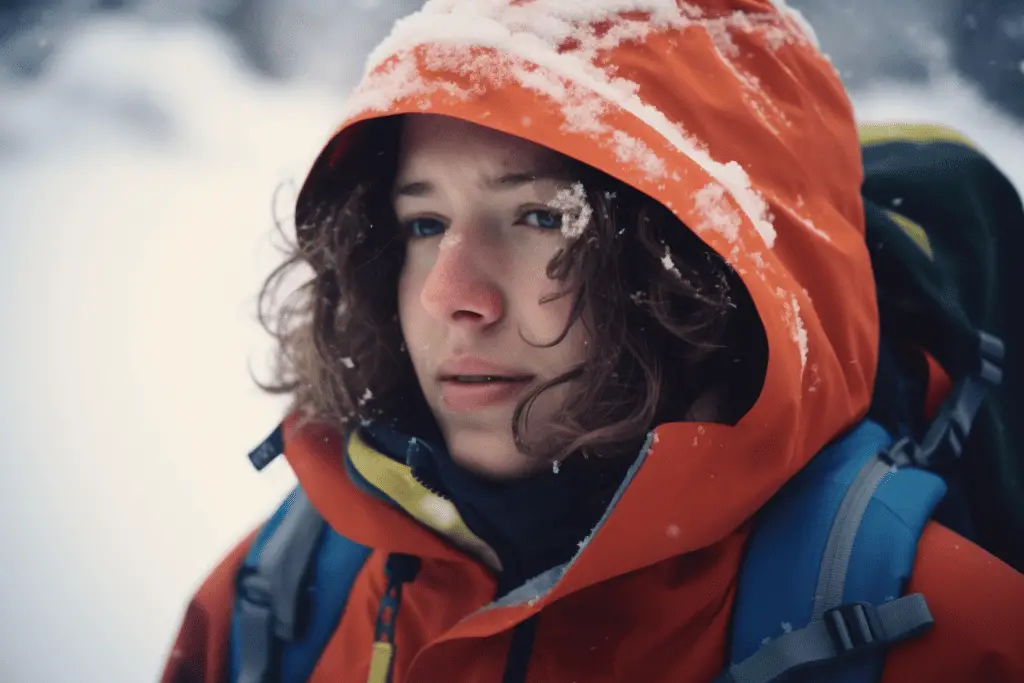
Now that you’re a bit more familiar with your icy playground, let’s dive into the core principle of dressing for winter hikes – layering. You know, like an onion, but more fashionable and a lot less teary. The goal of this approach is to help you manage your body temperature, keep you dry, and shield you from the elements, all by stacking different types of clothing.
The first layer, known as the base layer, is your personal climate control system. Its primary job is to wick away sweat from your skin to keep you dry. This might seem counterintuitive for cold weather, but trust us, getting sweaty then chilly is not a great combo when you’re miles from the nearest warm beverage.
Next up, we have the mid-layer or the insulation layer. This is like your personal space heater. Its purpose is to trap your body heat and create a cozy buffer against the cold. The thickness of this layer will depend on how cold it is outside, and remember, you can always add more mid-layers if you need to.
Last but not least, there’s the outer layer. Think of this as your bodyguard against rain, snow, and wind. It needs to be tough enough to resist the elements but breathable enough to let moisture escape.
Sounds easy enough, right? The trick is to choose the right materials for each layer (more on that in a bit) and to adjust your layers as needed. If you start feeling too warm, unzip or shed a layer. If you’re feeling cold, add a layer. Remember, the beauty of layering is its adaptability, allowing you to customize your comfort no matter what Mother Nature throws at you. So get ready to channel your inner onion and layer up for your winter hiking adventure!
Top Must-Have Base Layers for Winter Hiking
Let’s dig a bit deeper into that first line of defense – your base layer. When deciding what to wear winter hiking, choosing the right base layers can make a world of difference to your comfort. Think of these as your second skin; their job is to whisk away your sweat, leaving you feeling dry and cozy.
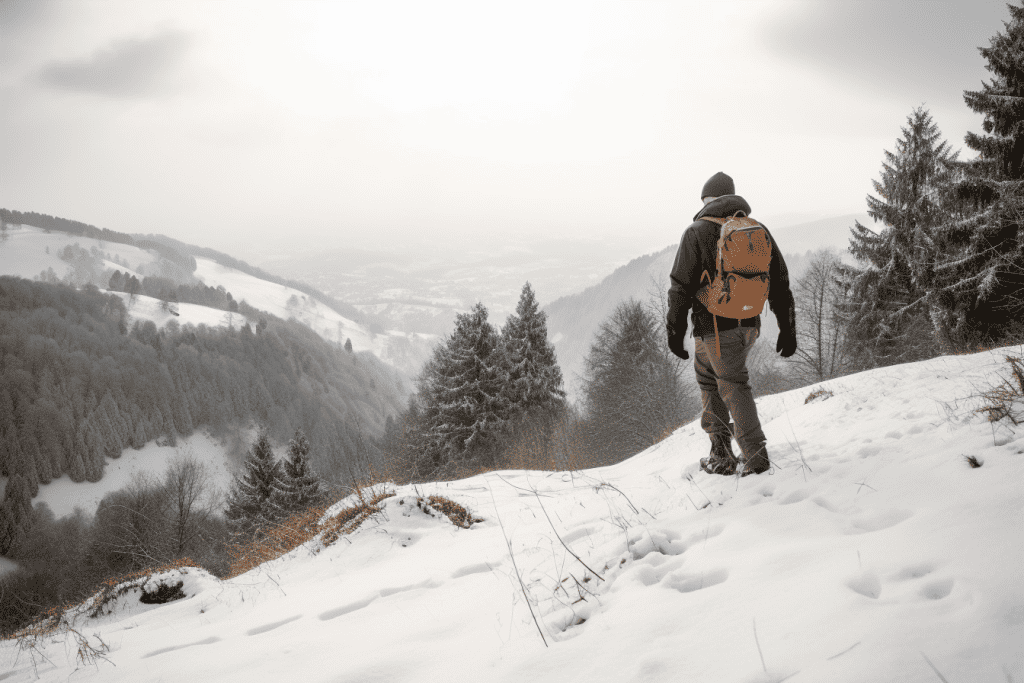
First things first, when it comes to base layers, materials matter. Cotton may be your best friend in the summer, but in winter, it’s a no-go. Why? It absorbs sweat and stays wet, which can leave you shivering once you stop moving. So, instead, opt for materials like synthetic polyester or merino wool. They’re excellent at wicking moisture away from your skin and they dry quickly too.
For colder conditions, a thicker, long-sleeve merino wool top, paired with long johns, can be a great choice. They deliver warmth without bulk and resist odors – a nice bonus for multi-day hikes. For milder weather, a lighter synthetic top might be enough, perhaps with a pair of leggings if you’re someone who feels the cold.
Don’t forget about your feet, either. When considering what to wear winter hiking, a pair of moisture-wicking socks, ideally made of merino wool, can keep your toes toasty and blister-free. Taking care of your feet is essential for a comfortable and enjoyable winter hiking experience, so make sure to choose the right socks to keep you warm, dry, and ready to tackle the trails.
Ladies, a quick note for you: don’t skimp on a good sports bra. It might not seem like it matters, but the right sports bra can provide great comfort and support during your hike. Look for one made from synthetic materials for the same moisture-wicking benefits.
Remember, the goal of your base layer is to manage moisture and maintain a dry microclimate next to your skin. By choosing the right materials and fit, you’ll set a solid foundation for the rest of your winter hiking outfit.
The Best Mid Layers for Hiking in Winter
Now that you’ve got your base layer figured out, let’s move to the next step in our layering strategy – the mid-layers. Their job description? Act as your personal insulation, trapping the heat your body generates to keep you warm. But, just like a good comforter, they need to keep you snug without making you sweaty. That’s where finding the right balance between warmth and breathability comes in.
When it comes to mid-layers, you have a few options. Fleece jackets are a popular choice, offering a good warmth-to-weight ratio, and they’re breathable and fast-drying too. Plus, they come in different thicknesses, so you can adjust them according to the weather and your activity level.
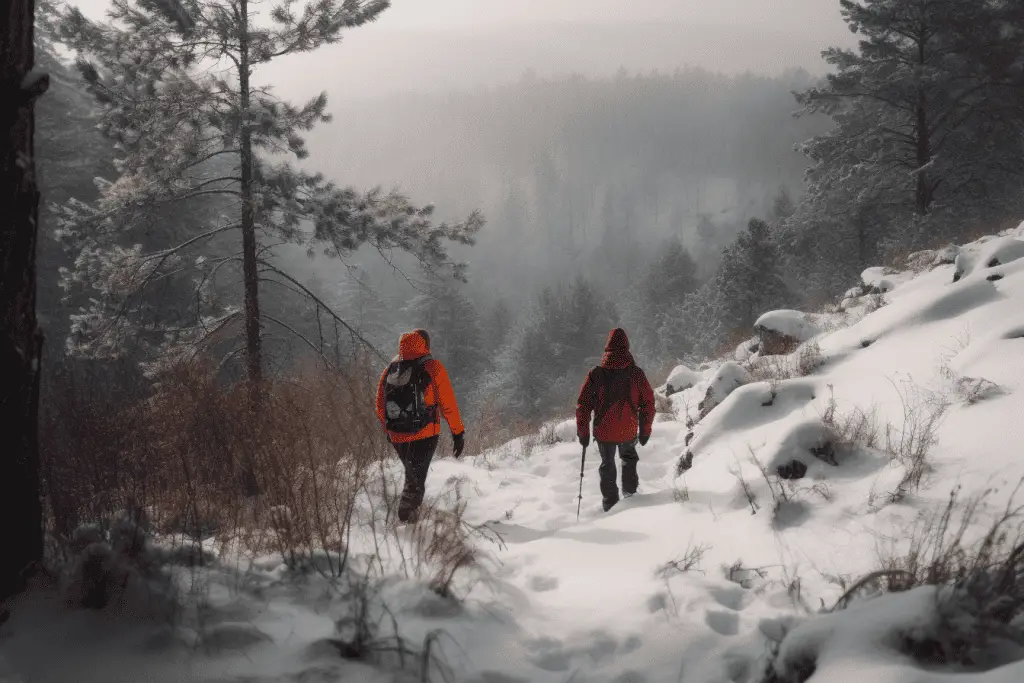
For colder conditions, a lightweight down or synthetic puffer jacket can be a fantastic addition. Down jackets are incredibly warm and packable but can lose their insulating properties when wet. Synthetic insulation, on the other hand, still performs when wet and dries faster, but it’s a bit bulkier.
Keep in mind, though, it’s not just about your torso. Think about a pair of fleece pants or a down skirt to insulate your lower body too. And don’t forget about your hands – a pair of lightweight, insulated gloves can make a big difference on a cold day.
The key to getting your mid-layers right is flexibility. Being able to add or shed layers easily allows you to respond to changes in your body temperature and weather conditions. And remember, it’s better to start a bit chilly and let your body heat warm you up as you hike. Overheating can lead to sweating, which is exactly what we’re trying to avoid when we’re deciding what to wear winter hiking.
Outer Layers for Winter Hiking
Alright, you’ve got your sweat-management and personal-heating system sorted with your base and mid-layers. Now, it’s time to talk about the final frontier of your winter hiking outfit – the outer layers. These are your fortress against rain, wind, and snow, and they’re vital in keeping you dry and warm.
When it comes to outer layers, what you’re looking for is a balance between protection and breathability. You need a layer that can repel water from snow or rain, block out the wind, yet still allow the moisture your body produces to escape. That’s where materials like Gore-Tex or eVent come into play, providing waterproof, windproof, and breathable solutions.
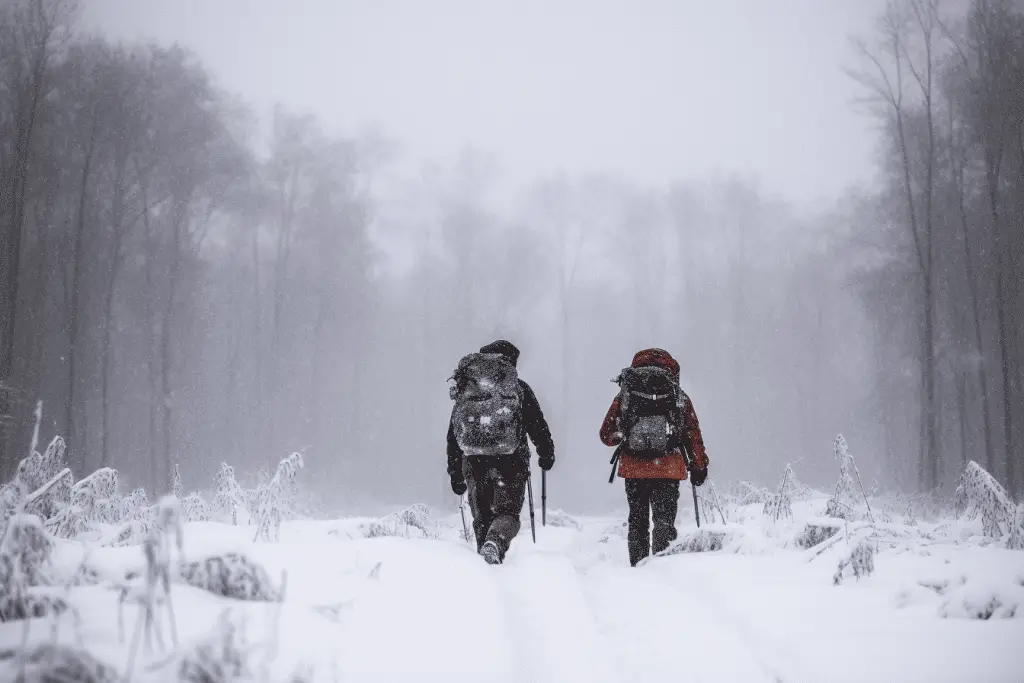
A waterproof, breathable jacket (often called a hard shell) should be a staple in your winter hiking wardrobe. Features to look for include a good hood, ample pockets for easy access to essentials, and underarm vents that you can unzip if you start overheating. For your lower body, waterproof and breathable hiking pants will help keep you dry when you’re trekking through snow.
But don’t overlook the smaller stuff. When it comes to what to wear winter hiking, a good pair of waterproof gloves and a cozy beanie, or even a balaclava, can provide critical insulation for your head and hands. These essential accessories can be game-changers on a wet and windy day, ensuring your comfort and enhancing your overall winter hiking experience.
Your outer layer is your primary defense against the winter elements, and while it’s not always needed in mild weather or light activity, it becomes critical in harsh conditions. After all, staying dry is not just a matter of comfort, but also safety when you’re figuring out what to wear winter hiking. Always be prepared for the unexpected and make sure you have your shield ready, no matter what the forecast says.
Choosing the Best Footwear for Winter Hiking
We’ve covered everything from head to nearly toe. Now let’s get to the foundation of your winter hiking outfit – your footwear. When you’re navigating snowy and icy trails, the right shoes can mean the difference between an enjoyable trek and a slip-sliding struggle.
First off, you’ll need a good pair of hiking boots. Look for boots that are insulated, waterproof, and provide good ankle support. Insulation is crucial to keep your feet warm, waterproofing keeps your feet dry, and ankle support is beneficial for stability on uneven or slippery terrain.
The fit is equally important. You don’t want boots that are too tight, as that can restrict your circulation and make your feet cold faster. And boots that are too loose can lead to blisters. So take the time to find a pair that fits you well, and remember to try them on with the same kind of socks you’ll be wearing on your hike.
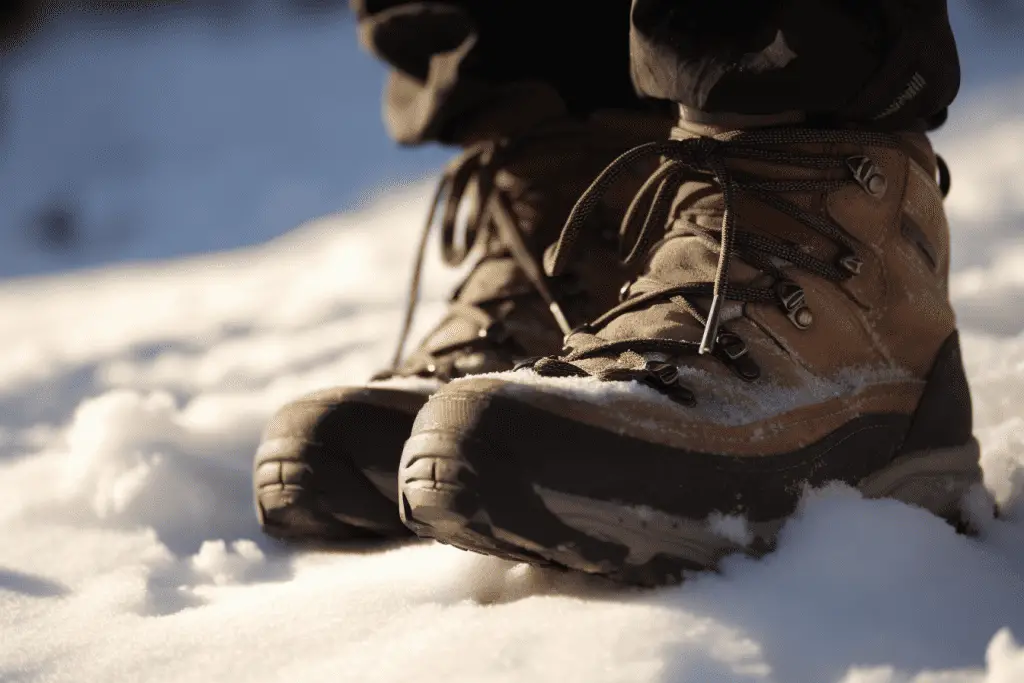
But what about when it’s icy? That’s where traction devices like crampons or microspikes come in. These devices attach to your boots and dig into ice or packed snow, giving you better grip and reducing your risk of slipping. They’re not always necessary, but in certain conditions, they can be invaluable.
And let’s circle back to socks – because they deserve a mention of their own. As we’ve said earlier, opt for moisture-wicking materials like merino wool. You might also want to consider a thinner liner sock underneath your main hiking sock, to add an extra layer of moisture management.
So, lace up your boots, strap on those crampons if needed, and step onto those winter trails with confidence. With the right footwear, you’ll be ready to tackle whatever the trail throws at you.
Adapting Your Outfit: Dressing for Different Winter Hiking Conditions
By now, you’ve got a pretty good idea of the different elements that make up a solid winter hiking outfit. But, as with most things in life, there isn’t a one-size-fits-all solution when deciding what to wear winter hiking. Different conditions call for different gear, and learning how to adapt your attire is crucial.
Imagine you’re heading out on a sunny, mild winter day. The temperature is hovering just around freezing, and there’s no snow in the forecast. You might be okay with a synthetic base layer, a light mid-layer like a fleece jacket, and some regular hiking pants. Don’t forget your waterproof boots and a beanie or hat for your head, though.
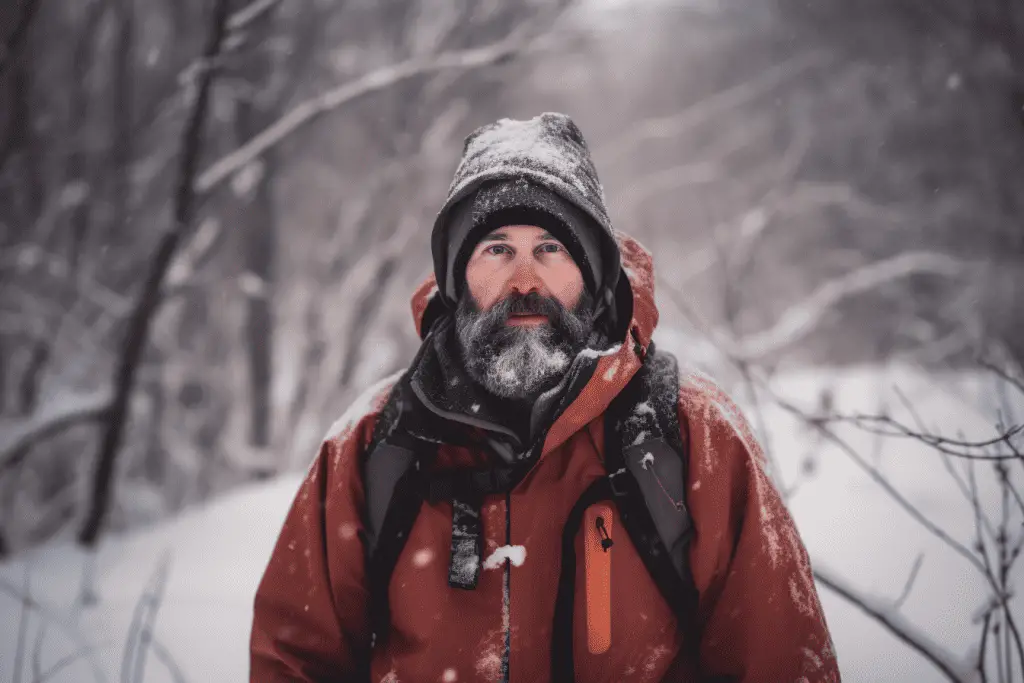
Now, let’s crank up the cold a notch. It’s well below freezing, and there’s a fair chance of snow. You’re going to want to add an extra mid-layer or choose a thicker one, go for a thicker base layer, and make sure your outer layer is ready to repel snow. You might want to add insulated pants and definitely some insulated gloves. And remember to protect your face with a scarf, balaclava, or neck gaiter.
And what about those bitter, frigid days when the temperature plunges way below freezing? That’s when you’ll be grateful for down insulation, thermal base layers, and possibly even heated insoles or hand warmers. Don’t skimp on covering your extremities either – frostbite is no joke.
The key takeaway? Be adaptable. Look at the weather forecast, understand the conditions you’ll be hiking in, and adjust your layers accordingly. And remember, it’s always better to be over-prepared than under-prepared. It’s easier to remove an unneeded layer than to magically produce one you left at home! So, gear up, and get ready to enjoy winter’s wonderland with confidence!
Mistakes to Avoid
As you gear up for your next winter hiking adventure, it’s crucial to ensure that you’re properly dressed for the conditions. Avoid the common mistakes and learn what to wear winter hiking, even for experienced hikers. By arming yourself with the right knowledge, you’ll be ready to conquer the chill and enjoy a comfortable journey.
Below, we’ve compiled a list of common winter wardrobe missteps that you’ll want to avoid. By understanding these pitfalls and how to sidestep them, you’ll be well-equipped to stay warm, dry, and comfortable throughout your journey. So, let’s dive in and explore how you can elevate your winter hiking experience to new heights.
- Choosing the wrong fabrics: Keep cotton out of your winter hiking gear. Once cotton gets wet, it stays wet, which can make you feel cold and uncomfortable. Opt for moisture-wicking fabrics like synthetic blends or merino wool instead.
- Overdressing: You might think that putting on your warmest clothes is the best way to tackle cold weather, but if you start sweating, your clothes will get damp and you’ll feel colder. It’s better to start off a little cool and then add layers as needed.
- Neglecting your extremities: Don’t forget that a lot of body heat is lost through the head, hands, and feet. Invest in a good beanie or balaclava, insulated gloves, and quality thermal socks to keep these areas warm.
- Underestimating the wind: Even a slight breeze can significantly lower the perceived temperature, making you feel much colder than the actual temperature suggests. Always have a windproof outer layer at hand, even if it’s a clear day, to protect yourself from those chilling gusts.
Remember these points when planning your winter hiking outfit and you’ll be well on your way to a more comfortable and enjoyable experience on the trails. It’s all about balancing warmth, moisture management, and protection from the elements.
Caring for Your Gear
You’ve invested time and money into carefully selecting your winter hiking gear. Now, it’s equally important to look after your gear properly. Regular maintenance and proper storage can extend the life of your equipment and keep it performing at its best, so you can focus on enjoying your winter hiking adventures.
When it comes to clothing, always follow the manufacturer’s care instructions. Most synthetic and woolen clothes can be machine washed, but always check the labels first. Avoid using fabric softener, as it can reduce the wicking properties of technical fabrics. If your waterproof jackets or pants lose their water-repellency, consider using a reproofing treatment to restore it.
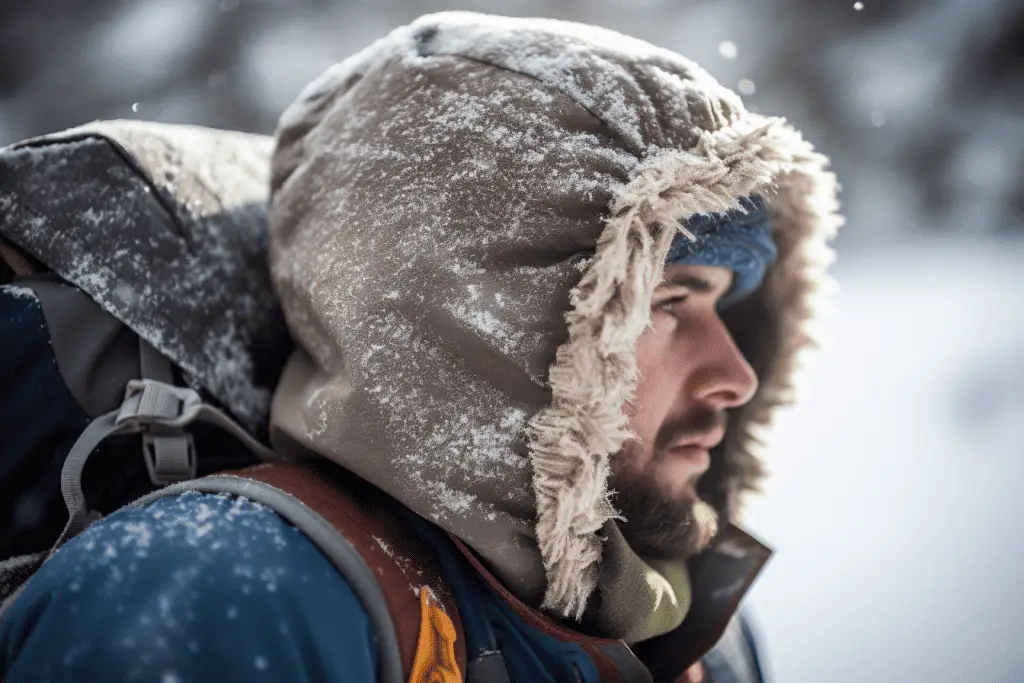
For your hiking boots, clean off any mud or dirt after your hikes to prolong their life. If they’re wet, let them dry naturally away from direct heat, which can damage the material. And don’t forget about your boot’s interior – remove the insoles and air them out after every hike.
Now, storage. Your gear needs a cool, dry place to rest between adventures. Avoid stuffing your clothes into a drawer; instead, let them breathe. Store your boots upright, ideally on a shoe rack, and avoid placing heavy items on top of them. If you’re stashing away your gear for a while, make sure everything is clean and dry to prevent any mildew or unpleasant odors.
In short, a little love and care can go a long way in maintaining your winter hiking gear. So invest the time in proper maintenance and storage, and your gear will surely return the favor by keeping you warm and dry on many winter hikes to come.
Embrace the Cold with Confidence
As we wrap up this guide on what to wear winter hiking, we hope that you’re feeling ready and equipped to embrace the cold weather with confidence. Remember, it’s all about the layers – moisture-wicking base layers to keep you dry, insulating mid-layers to trap heat, and protective outer layers to shield you from the elements.
Don’t forget the importance of proper footwear, and remember to protect your extremities, where you lose a lot of your body heat. Be flexible and adaptable, adjusting your layers to the specific conditions you’re hiking in, and try to avoid the common pitfalls we discussed.
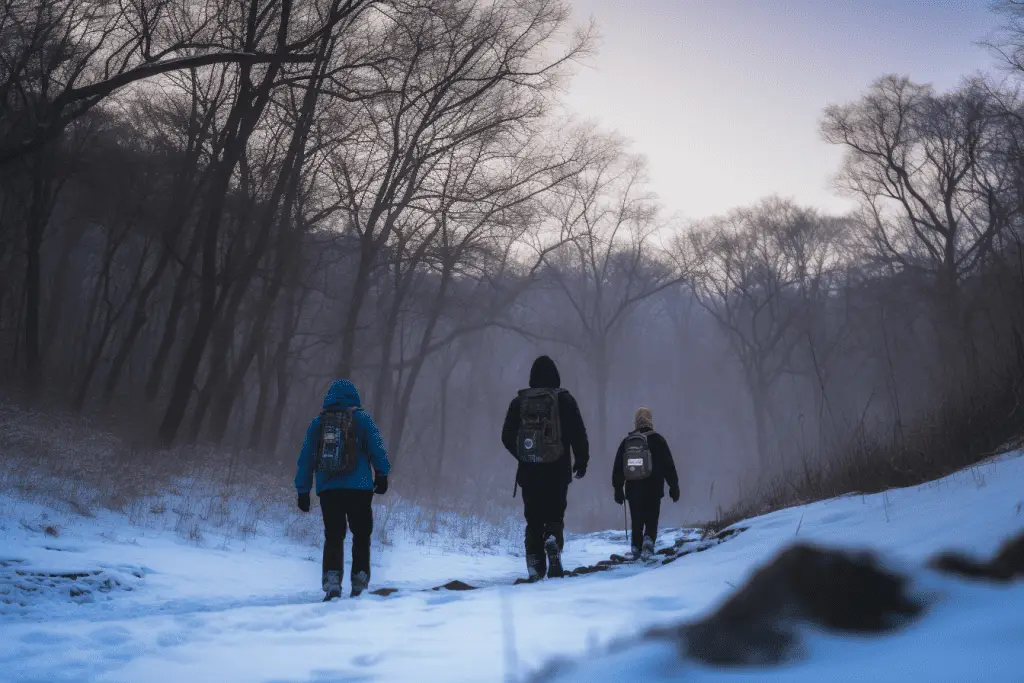
Knowing how to care for your winter hiking gear is almost as important as knowing what to wear winter hiking. Regular cleaning, careful maintenance, and proper storage can prolong the life of your equipment, ensuring that it’s always ready to support you in your winter hiking adventures.
And most importantly, enjoy it! Winter hiking is a fantastic way to get outdoors, stay active, and enjoy the beautiful, snowy landscapes that the colder months bring. With the right attire, you’ll be warm, dry, and comfortable on your hikes – ready to fully immerse yourself in the winter wonderland around you.
